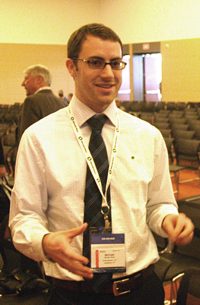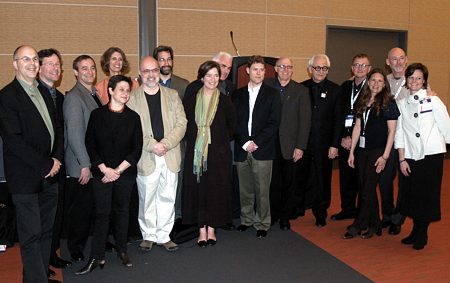Blog Post
COTE's Top Ten Green Projects Presentation at AIA'08

- Sustainable design intent & innovation: Sustainable design is an inherent aspect of design excellence. Projects should express sustainable design concepts and intentions, and take advantage of innovative programming opportunities.
- Regional community design / connectivity: Sustainable design values the unique cultural and natural character of a given region.
- Land use & site ecology: Sustainable design protects and benefits ecosystems, watersheds, and wildlife habitat in the presence of human development.
- Bioclimatic design: Sustainable design conserves resources and maximizes comfort through design adaptations to site-specific and regional climate conditions.
- Light & air: Sustainable design creates comfortable interior environments that provide daylight, views, and fresh air.
- Water cycle: Sustainable design conserves water and protects and improves water quality.
- Energy flows & energy future: Sustainable design conserves energy and resources and reduces the carbon footprint while improving building performance and comfort. Sustainable design anticipates future energy sources and needs.
- Materials & construction: Sustainable design includes the informed selection of materials and products to reduce product-cycle environmental impacts, improve performance, and optimize occupant health and comfort.
- Long life & loose fit: Sustainable design seeks to enhance and increase ecological, social, and economic values over time.
- Collective wisdom & feedback loops: Sustainable design strategies and best practices evolve over time through documented performance and shared knowledge of lessons learned.

Yale Sculpture Building and Gallery; New Haven, Connecticut
Though budgeted for LEED Silver, the design team achieved LEED Platinum. They met weekly during the scant 21 months they were given to design and construct this university building. Measure 2: Regional community design / connectivity
Macallen Building Condominiums; Boston, Massachusetts
A LEED Gold spec-built 140-unit condo designed to promote green lifestyle for residents and nonresidents alike. (It was noted that a nonchemical cooling tower water treatment system was used, but not which one. Blowdown is captured to irrigate one of the green roofs.) Measure 3: Land use & site ecology
Queens Botanical Garden Visitor Center; Flushing, New York
Set in a legacy site of two world's fairs, more than a third of the materials used to build this free-and-open-to-the-public center were local. Measure 4: Bioclimatic design
SUPPORT INDEPENDENT SUSTAINABILITY REPORTING
BuildingGreen relies on our premium members, not on advertisers. Help make our work possible.
See membership options »Garthwaite Center for Science and Art; Weston, Massachusetts
A high school building designed with student involvement. A design team member noted, "It was exciting to se how proactive students were in developing green strategeis and holding us accountable." Measure 5: Light & air
Lavin-Bernick Center; New Orleans, Louisiana
This student center at Tulane University built out from the concrete structure of an existing building is passively cooled for five months of the year in that hot and humid climate. "If there's an example of Alex Wilson's passive survivability, this is it," noted Rebecca Henn. Measure 6: Water cycle
Cesar Chavez Library; Laveen, Arizona
Despite having a lawn in the desert, the jury — after long and lively debate — came away impressed with the rooftop rainwater collection system that balances this building's water use. Measure 7: Energy flows & energy future
Aldo Leopold Legacy Center; Baraboo, Wisconsin
One of the highest scoring LEED Platinum projects, most of the wood for this net exporter of energy (the owner challenged the designers to make it a carbon neutral project) was not only FSC certified, but came from trees harvested on the site that were planted by the family in the '30s and '40s. An engineer from the project team noted that they were able to downsize just about everything in the thermal comfort and ventilation systems by completely separating them, including the ducts. Measure 8: Materials & construction
Pocono Environmental Education Center; Dingmans Ferry, Pennsylvania
An unusual visual aspect of this National Park Service building is the use of wall shingles site-cut from dead auto tires, many reclaimed from the the Delaware River. Measure 9: Long life & loose fit
South Lake Union Discovery Center; Seattle, Washington
A temporary, modular exhibit space designed for disassembly and relocation. "It's not about its site — it's about several sites." It uses air-source heat pumps for conditioning. Measure 10: Collective wisdom & feedback loops
Nueva School Hillside Learning Complex; Hillsborough, California
Marvin Malecha summed it up: "A great integration of simple, climate-based design approaches that goes beyond any checklist," adding wryly, "It's not a typical schoolbuilding that children have to confront." Honorable Mention
Internal Revenue Service, Kansas City Campus; Kansas City, Missouri
Nearly a million square feet! "A building type that could have been awful in so many ways..." "Poor performance could have resulted in gargantuan consequences..." Yet they managed to avoid what so easily, and so often, are the hallmarks of these kinds of buildings.
Published May 17, 2008 Permalink Citation
(2008, May 17). COTE's Top Ten Green Projects Presentation at AIA'08. Retrieved from https://www.buildinggreen.com/blog/cotes-top-ten-green-projects-presentation-aia08



Add new comment
To post a comment, you need to register for a BuildingGreen Basic membership (free) or login to your existing profile.